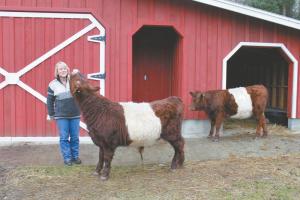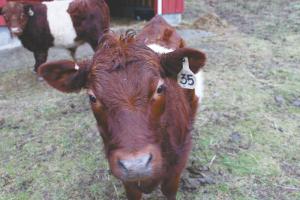Miniature Kingshire Cattle Ideal For Small Farms
When you have a small farm of only 10 acres, it only makes sense to raise miniature cattle, says Eric Little. Though there are many breeds to choose from, he and his wife, Sherri, found themselves attracted to a new breed called Kingshire® that was named after King County, Wash., where they were developed by Richard and Arlene Gradwohl.
By an unexpected stroke of genetics the miniature Angus and Hereford and mid-size Scottish Highlanders cross also developed a well-defined belt that goes completely around its middle.
“They are so darn cute,” admits Little, citing that as one reason for choosing the breed. He also appreciates that they are docile and polled. But what really sold the couple was tasting grilled Kingshire beef burgers.
“One bite and both of us said it was the best burger we’ve ever tasted,” Little explains.
“They aren’t a toy breed; they are just a small cow,” Little adds. That means they are 42 in. or less to the top of the rear hipbone at 3 years old.
Jim Haack, who sold the Littles a pair of Kingshires last fall, describes the ideal shape as “a whiskey barrel on legs”.
Heifers gain up to 700 lbs. and bulls about 1,000 lbs. Typically, Kingshires are butchered at 700 lbs. at 18 mos. and dress out to 500 lbs. hanging weight. They flourish on pasture/hay and have short muscle fibers so the meat is tender and flavorful.
Kingshires have the same characteristics as other miniature breeds: easier to manage and easier on equipment and fencing; they eat about a third the feed of regular size cattle; and you can have a higher capacity beef production with only one acre required for two miniatures. A higher percent of body mass converts to beef because of lower fat and bone mass.
In restoring the small family farm on Whidbey Island, Wash., where Little’s parents live, the miniature breed fits in well. Little’s father, 84, can easily feed and care for them, and once the land is fully fenced in, it should support two cows, a bull and yearling calves.
“They are very feed efficient,” Little says. “Bart is 450 lbs. and Bonnie is 80 lbs. less, and I’ve only gone through 20 bales in 2 1/2 months.”
Little feeds them two 60-lb. bales a week plus treats such as mangel beets, apples and beet pulp and alfalfa pellets. Though Kingshire are hearty in most climates, Little built them a barn where they can go for shelter – especially during the rains common on the island.
The Littles made the $6,500 investment in the breeding pair with the intent of raising Kingshire cattle for meat. They purchased them from K-T Cattle Company, and owners Katie and Jim Haack delivered them to the Littles’ island farm.
Kingshire is a registered miniature cow breed. For more information, Little suggests contacting the Haacks (www.ktcattlecompany.com) or the International Miniature Cattle Breeder’s Society and Registry ( www.minicattle.com), founded by Gradwohl, who developed the breed.
Check out a video of the breed at www.FARMSHOW.com
Contact: FARM SHOW Followup, Eric Little, 1971 Amanda Ln., Freeland, Wash. 98249 (ph 360 730-4799; ericwane@gmail.com).

Click here to download page story appeared in.
Click here to read entire issue
Miniature Kingshire Cattle Ideal For Small Farms LIVESTOCK Beef When you have a small farm of only 10 acres it only makes sense to raise miniature cattle says Eric Little Though there are many breeds to choose from he and his wife Sherri found themselves attracted to a new breed called Kingshire® that was named after King County Wash where they were developed by Richard and Arlene Gradwohl By an unexpected stroke of genetics the miniature Angus and Hereford and mid-size Scottish Highlanders cross also developed a well-defined belt that goes completely around its middle “They are so darn cute ” admits Little citing that as one reason for choosing the breed He also appreciates that they are docile and polled But what really sold the couple was tasting grilled Kingshire beef burgers “One bite and both of us said it was the best burger we’ve ever tasted ” Little explains “They aren’t a toy breed; they are just a small cow ” Little adds That means they are 42 in or less to the top of the rear hipbone at 3 years old Jim Haack who sold the Littles a pair of Kingshires last fall describes the ideal shape as “a whiskey barrel on legs” Heifers gain up to 700 lbs and bulls about 1 000 lbs Typically Kingshires are butchered at 700 lbs at 18 mos and dress out to 500 lbs hanging weight They flourish on pasture/hay and have short muscle fibers so the meat is tender and flavorful Kingshires have the same characteristics as other miniature breeds: easier to manage and easier on equipment and fencing; they eat about a third the feed of regular size cattle; and you can have a higher capacity beef production with only one acre required for two miniatures A higher percent of body mass converts to beef because of lower fat and bone mass In restoring the small family farm on Whidbey Island Wash where Little’s parents live the miniature breed fits in well Little’s father 84 can easily feed and care for them and once the land is fully fenced in it should support two cows a bull and yearling calves “They are very feed efficient ” Little says “Bart is 450 lbs and Bonnie is 80 lbs less and I’ve only gone through 20 bales in 2 1/2 months ” Little feeds them two 60-lb bales a week plus treats such as mangel beets apples and beet pulp and alfalfa pellets Though Kingshire are hearty in most climates Little built them a barn where they can go for shelter – especially during the rains common on the island The Littles made the $6 500 investment in the breeding pair with the intent of raising Kingshire cattle for meat They purchased them from K-T Cattle Company and owners Katie and Jim Haack delivered them to the Littles’ island farm Kingshire is a registered miniature cow breed For more information Little suggests contacting the Haacks www ktcattlecompany com or the International Miniature Cattle Breeder’s Society and Registry www minicattle com founded by Gradwohl who developed the breed Check out a video of the breed at www FARMSHOW com Contact: FARM SHOW Followup Eric Little 1971 Amanda Ln Freeland Wash 98249 ph 360 730-4799; ericwane@gmail com
To read the rest of this story, download this issue below or click
here to register with your account number.








